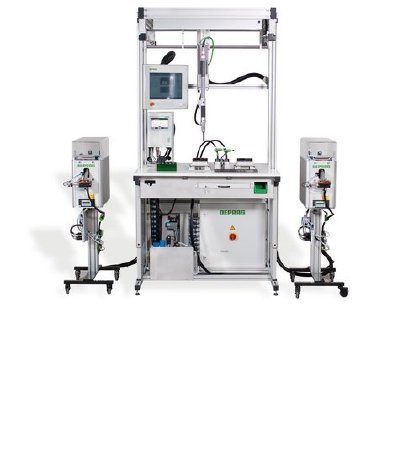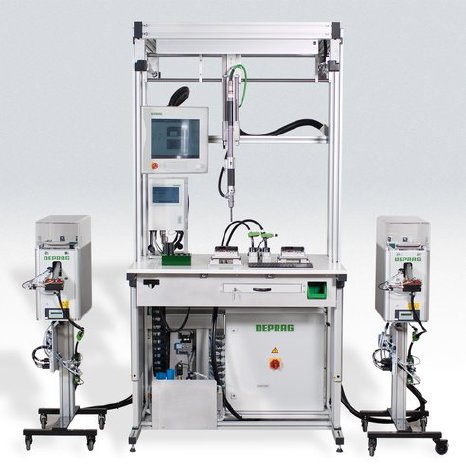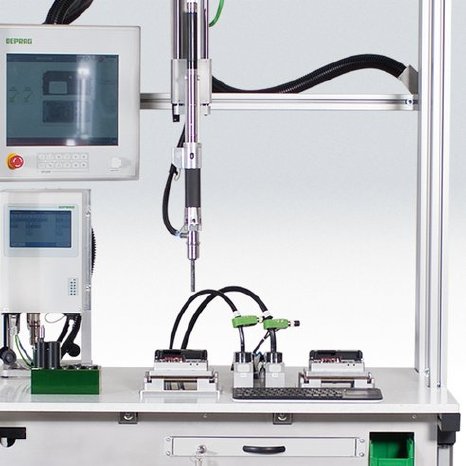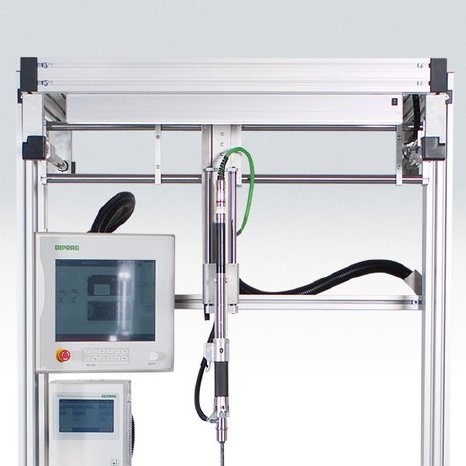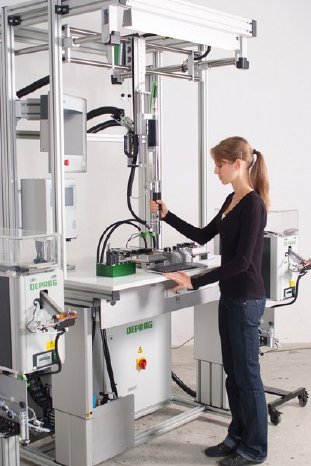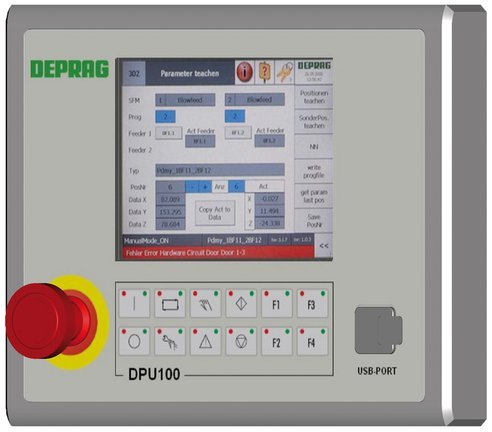These high standards of processing reliability and documentation advocate an automatic solution which eliminates the possibility of human error. The required flexibility and adaptation to varied production versions however recommends a flexible operator controlled semi-automatic assembly solution. "There are several options in approaching this assembly task" explains Jürgen Hierold, Sales Manager at DEPRAG SCHULZ GMBH u. CO. "In this instance I would suggest a flexible upgradeable assembly line with intelligent manual work station".
But what exactly is an "intelligent manual work station"? On an intelligent manual work station processing reliability is guaranteed just as it is on an automatic assembly system. As a reaction to increased demand of one HCU version it can be upgraded to a semi- or fully-automatic production line. The specialists at DEPRAG SCHULZ GMBH u. CO have been engaged for decades with the complex demands of reliable screw assembly. They offer a comprehensive programme of sophisticated standard modules from which the manual work stations can be reliably, economically and ergonomically built. The structure of the manual work station is ingeniously conceived and designed to suit the required standards of processing reliability. Jürgen Hierold clarifies, "It is particularly important to define the requirements for processing reliability in advance. Processing reliability is based on reliable repeatability of the individual processing steps and parameters within pre-set tolerances. The size of the tolerance window for components defines the level of quality". If the demands and solutions for processing reliability throughout the entire assembly process are set and recorded in detail then errors during the conceptual phases can be eliminated. It is these errors which are most difficult and expensive to correct later on.
The flexibility required by Mr Smith can also influence various processing steps. Therefore during planning the type of flexibility required must be addressed and defined. Does the demand for flexibility influence production procedures? How often will it be necessary to convert the machine? What is the product's life span? What should happen to the manual work station once the product is no longer produced? How many alterations to production numbers are expected and must each manual work station be able to produce all three models? DEPRAG has a solution ready for every question. It is important to ask the questions at the right time. For example: A combined screw feeding device supplies different types of screw to a screwdriver. This is precisely directed using a screwdriver positioning portal: The XY coordinates of the screw assembly position are recognised by the portal, communicated to the feeding system and screwdriving controller and then the required screw fastener and screwdriving parameters are selected. In this way using one manual work station all models, HCU25 with M3x8 screw, HCU50 with M3x10 screws and HCU100 with M4x12 screws can be reliably assembled. The correct screw is always supplied and assembled using the correct torque. The requirements from Mr Smith to ensure that the sequential order of screw assembly is followed can also be controlled by the screwdriver positioning portal. If the screwdriver is positioned over the wrong screw location it will not run. Screw assembly will only be completed if the correct order is adhered to.
Using interchangeable adaptors, assembly can be flexibly converted to the various sizes of HCU25, HCU50 and HCU100. Work piece adaptors are equipped with integrated sensor technology and communicate with a superior controller.
Jürgen Hierold explains: "For the assembly of the HCU units for our customers there were particularly tight windows of tolerance and the quality requirements were very high. One factor in the fulfilment of these requirements was the selection of the most suitable screwdriving technology". Electronic freely programmable screwdriving tools enable the evaluation of screwdriving parameters, statistical calculations, product data acquisition, links to manufacturing execution systems, documentation and archiving of assembly results. High processing reliability during the individual assembly steps guarantees work station components which are systematically designed to suit the application. All system components must harmonise, interact and communicate with one another. As well as tried and tested high quality screwdriving tools there are screw and part feeders, screwdriver positioning systems for reliable operator guidance, screwdriver and sequence controllers with corresponding software, and part adaptors and positioning equipment all harmonised to suit one another.
It is only a manual work station which incorporates an operator's needs right from the start which can guarantee optimal production. Under the keyword ergonomics, DEPRAG places emphasis on a series of solutions which play a role in equipping a user friendly work place. They are focused on fatigue-free reliable operation, safety in the workplace, operator friendly activation, clear displays, evaluation and troubleshooting of processing data and errors. An optimal flow of materials and the ergonomic design of the screwdriving tool are also important. The acceptance of the working environment by the operator will also be increased by the clear HMI (human machine interface) with optimal visualisation, user friendly hardware and software which is easy to understand. Only those who enjoy their work are good at it.
When assembling highly sensitive printed circuit boards for the HCU series on intelligent manual work stations the electronic components are protected by targeted electro-static discharge. The ESD-enabled DEPRAG solutions function continuously (for all components of the manual work stations) and this is recordable and verifiable for the end-user. The same care is taken in the realisation of technical cleanliness. Dirt particles can damage sensitive components. They can be created in the feeding of connection elements or by screw assembly itself. To minimise the danger of dirt particles in the production process the following can be utilised: feeding systems without vibration, positioning and assembly of connection parts with vacuum suction or particle killers. The requirements for technical cleanliness and ESD-capability should be continuously realised for all individual components of a system. It is therefore of a great advantage when all components are coordinated.
"The collaboration with DEPRAG has been impressive. All our technical requirements were realised with already existing harmonised standard components within the shortest space of time. And what is particularly important for us, all system components come to us from one source. When we need to increase our production capacity we can flexibly expand our assembly line".
Under the slogan "Intelligent - Manual - Assembly" DEPRAG displays an intelligent assembly solution at this year's AUTOMATICA from the 3rd to the 6th of June. In Hall A6 at Stand 310 a complete manual work station has been installed where visitors can learn about the individual components providing processing reliability, flexibility, ergonomics, ESD-capability, technical cleanliness and cost-effectiveness.
